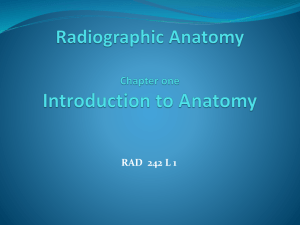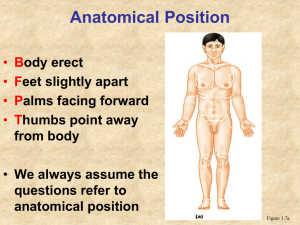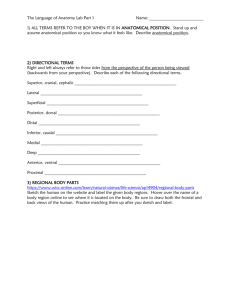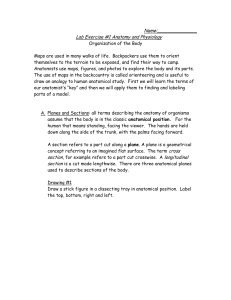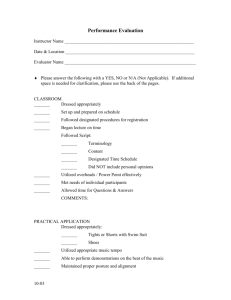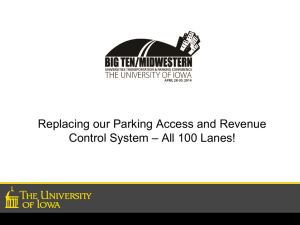NOVELTIES IN ANATOMY INSTRUCTION * GOOFY YET HIGHLY
advertisement
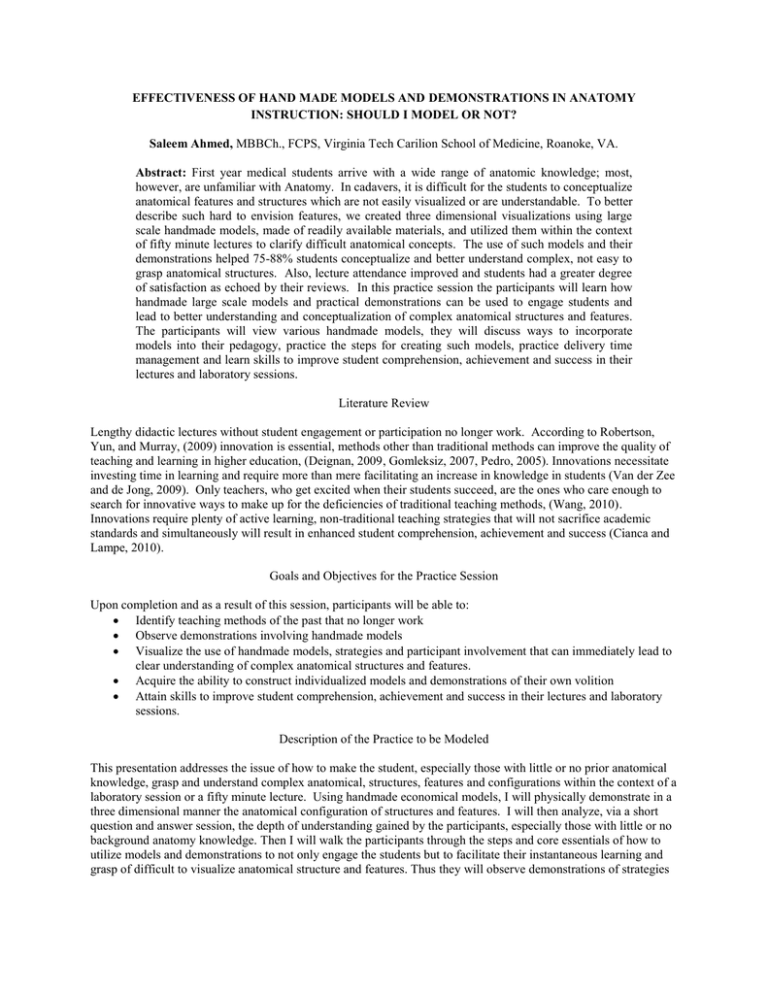
EFFECTIVENESS OF HAND MADE MODELS AND DEMONSTRATIONS IN ANATOMY INSTRUCTION: SHOULD I MODEL OR NOT? Saleem Ahmed, MBBCh., FCPS, Virginia Tech Carilion School of Medicine, Roanoke, VA. Abstract: First year medical students arrive with a wide range of anatomic knowledge; most, however, are unfamiliar with Anatomy. In cadavers, it is difficult for the students to conceptualize anatomical features and structures which are not easily visualized or are understandable. To better describe such hard to envision features, we created three dimensional visualizations using large scale handmade models, made of readily available materials, and utilized them within the context of fifty minute lectures to clarify difficult anatomical concepts. The use of such models and their demonstrations helped 75-88% students conceptualize and better understand complex, not easy to grasp anatomical structures. Also, lecture attendance improved and students had a greater degree of satisfaction as echoed by their reviews. In this practice session the participants will learn how handmade large scale models and practical demonstrations can be used to engage students and lead to better understanding and conceptualization of complex anatomical structures and features. The participants will view various handmade models, they will discuss ways to incorporate models into their pedagogy, practice the steps for creating such models, practice delivery time management and learn skills to improve student comprehension, achievement and success in their lectures and laboratory sessions. Literature Review Lengthy didactic lectures without student engagement or participation no longer work. According to Robertson, Yun, and Murray, (2009) innovation is essential, methods other than traditional methods can improve the quality of teaching and learning in higher education, (Deignan, 2009, Gomleksiz, 2007, Pedro, 2005). Innovations necessitate investing time in learning and require more than mere facilitating an increase in knowledge in students (Van der Zee and de Jong, 2009). Only teachers, who get excited when their students succeed, are the ones who care enough to search for innovative ways to make up for the deficiencies of traditional teaching methods, (Wang, 2010). Innovations require plenty of active learning, non-traditional teaching strategies that will not sacrifice academic standards and simultaneously will result in enhanced student comprehension, achievement and success (Cianca and Lampe, 2010). Goals and Objectives for the Practice Session Upon completion and as a result of this session, participants will be able to: Identify teaching methods of the past that no longer work Observe demonstrations involving handmade models Visualize the use of handmade models, strategies and participant involvement that can immediately lead to clear understanding of complex anatomical structures and features. Acquire the ability to construct individualized models and demonstrations of their own volition Attain skills to improve student comprehension, achievement and success in their lectures and laboratory sessions. Description of the Practice to be Modeled This presentation addresses the issue of how to make the student, especially those with little or no prior anatomical knowledge, grasp and understand complex anatomical, structures, features and configurations within the context of a laboratory session or a fifty minute lecture. Using handmade economical models, I will physically demonstrate in a three dimensional manner the anatomical configuration of structures and features. I will then analyze, via a short question and answer session, the depth of understanding gained by the participants, especially those with little or no background anatomy knowledge. Then I will walk the participants through the steps and core essentials of how to utilize models and demonstrations to not only engage the students but to facilitate their instantaneous learning and grasp of difficult to visualize anatomical structure and features. Thus they will observe demonstrations of strategies that build engagement, instant and clear comprehension and lifelong remembrance. Participants will be encouraged to actively take part in my demonstrations using handmade models. Discussion As an educator of anatomical sciences, I have often wondered, while delivering content in a traditional, didactic approach, the degree to which students, especially first year students, are fathoming and learning the content being delivered. I have attended lectures by Anatomy peers and have been in student’s seat. Slide after slide of power points has come across to me as another method of handing out study guides, especially when it involved difficult, hard to visualize, complex anatomical features, structures and their configuration. As the realization that traditional approaches were contributing minimally to student learning sank in, I decided to modify my own delivery of content and teachings to facilitate maximal student learning. Difficult concepts, such as configuration of pleura and thoracic structures, peritoneum and abdominopelvic structures were demonstrated, using transparent plastic sheets and sleeves; cardboard boxes; plastic bottles, condoms and balloon models. Students actively participated in these demonstrations. At the end of the lecture the students were surveyed on effectiveness of the demonstration using an audience response system. Demonstrations using inexpensive, easily reproducible models can be applied in any classroom setting; however, careful planning and rehearsal must precede their implementation since such demonstrations consume teaching time. Demonstrations, with active student role playing, of difficult concepts using models in a lecture greatly helped 75-88% of the students to conceptualize and to understand the arrangement of complex, not easy to grasp anatomic structures/features. Also, lecture attendance improved and students had a greater degree of satisfaction as seen in student reviews of the lectures, which revealed that such innovative demonstrations and the use of models were considered by the students an educative, entertaining, and meaningful experience. As one student commented, “We will never forget how, in your demonstration, students X, Y and Z were made to depict pelvic structures and how they modeled the configuration of the peritoneum over and around these structures. I feel like I have learned something for life and something worth emulating.” References Cianca, M, & Lampe, P. (2010, Sep) Restoring hope. Principal Leadership, 11, 50-55. Deignan, T. (2009, Feb). Enquiry-based learning: perspective on practice. Teaching in Higher Education, 14, 13-23. Gomleksiz, M.N., (2007, Oct) Effectiveness of cooperative learning (jigsaw II) method in teaching English as a foreign language to engineering students (Case of Firat University, Turkey). European Journal of Engineering Education, 32, 613-625. Pedro, F., (2005, Oct-Dec). Comparing Traditional and ICT-Enriched University Teaching Methods: Evidence from Two Empirical Studies. Higher Education in Europe, 30, 399-411. Robertson, J.L., Yun, H.C., & Murray, C.K., (2009). Teaching of interdisciplinary and core curriculum topics using alternative strategies. Military Medicine, 174, 1132-1136. Van der Zee, T, & de Jong, A. (2009). Teachers as a source of inspiration in Catholic Schools. Journal of Empirical Theology, 22, 7-29. Wang, Tsung Juang, (2010, Jan/Feb). Educational benefits of multimedia skills training. TechTrends, 54, 47-57.

